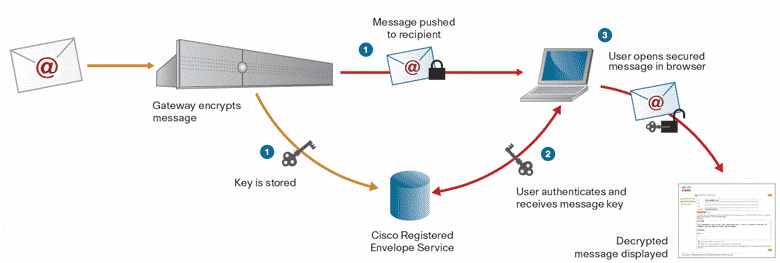Overview
Despite the rise in text messaging, instant messaging, social networking, and other forms of communication, email continues to be the predominant business collaboration tool. But the unsecure nature of email has resulted in the inadvertent and malicious exposure of sensitive information.
Technologies to encrypt email, such as S/MIME and Open PGP, have been available for several years, but they have failed to achieve widespread adoption. The limited use of these technologies is primarily due to their deployment complexity and the burden they place on the sender and the recipient to open and manage encrypted messages.
Cisco® IronPort Email Encryption overcomes the problems of earlier encryption technologies by providing a solution that that meets compliance requirements for email encryption, while delivering powerful new email control features—all in an easy-to-use, broad-reaching, and affordable offering.
The Cisco IronPort Difference:
Cisco IronPort email and web security products are high-performance, easy-to-use and technically-innovative solutions, designed to secure organizations of all sizes. Purpose built for security and deployed at the gateway to protect the world’s most important networks, these products enable a powerful perimeter defense. Leveraging the Cisco Security Intelligence Operations (SIO) center and global threat correlation makes the Cisco IronPort line of products smarter and faster. This advanced technology enables organizations to improve their security and transparently protect users from the latest Internet threats.
Features:
Integrated Functionality:
Along with RSA Email DLP, Cisco IronPort Anti-Spam, and Cisco IronPort Virus Outbreak Filters, Cisco IronPort Email Encryption is integrated into the high-performance line of Cisco IronPort email security appliances. Converging email functions into a single appliance means a simpler email infrastructure and lower capital and operational costs.
Flexible Sender Encryption:
The sender can initiate encryption through a wide variety of means, including installing an email client plug-in that allows them to encrypt a message with the click of a button, marking the message as urgent, or using a code word (such as “encrypt”) in the subject line. Emails can also be encrypted automatically through administrator-configured policies.
Support for All Email Platforms:
Messages encrypted using Cisco IronPort Email Encryption can be opened by any AOL, Yahoo!, Gmail, or Hotmail user, as well as by traditional enterprise email clients such as Outlook, Lotus Notes, and Groupwise.
Flexible Key Management:
Cisco takes the burden out of encryption key management through a hosted key management service. The Cisco Registered Envelope Service provides secure and transparent management of encryption key creation, distribution, and retention. Operating from multiple Cisco data centers, the service is fully redundant, with 99.999 percent availability and 10-year key retention. If an organization cannot permit a hosted key service, Cisco provides the flexibility of on-premises key management with the Cisco IronPort Encryption Appliance.

Benefits:
Easy to Set Up and Administer:
With Cisco IronPort Email Encryption, email administrators can implement message-level encryption in two easy steps and be up and running in minutes. Cisco transparently manages key creation, distribution, and retention, as well as recipient user management.
Total Email Control:
Unlike other email encryption solutions, Cisco IronPort Email Encryption allows the sender to continue to remain in full control of their content—even after it’s been sent. With Cisco IronPort Email Encryption, senders don’t have to fear mistyped recipient addresses, mistakes in content, or time-sensitive emails, because they always have the option to lock the message.
Regulatory Compliance:
Cisco IronPort Email Encryption satisfies the encryption requirements for regulatory requirements such as PCI, HIPAA, SOX, GLB—as well as state privacy regulations and European directives—without being a burden on the senders, recipients, or email administrators. Ease of use combined with powerful features means that now IT can offer encryption as a service, not a mandate.
Specifications:
| Chassis / Processor |
| Form Factor |
17" 1U rack mounted chassis |
| Dimensions |
1.7" (h) x 17" (w) x 22" (d) |
| CPU |
Single Intel Processor |
| Storage |
| RAID |
RAID 1 Configuration |
| Drives |
Two 250GB SATA Drives |
| RAM |
4GB |
| Connectivity |
| Ethernet |
Two Embedded Intel Gigabit NICs |
| Serial |
1 DB-9 Serial Port |
| Mail Operations |
| Mail Injection Protocols |
SMTP, ESMTP, Secure SMTP over TLS |
| Mail Delivery Protocols |
SMTP, ESMTP, Secure SMTP over TLS |
| DNS |
Internal resolver/cache; Can resolve using local DNS or Internet DNS servers |
| Interfaces / Configuration |
| Web Interface |
Accessible by HTTP or HTTPS |
| Command Line Interface |
Accessible via SSH or Telnet; Configuration Wizards |
| File Transfer |
SCP or FTP |
| Programmatic Monitoring |
XML-based Configuration Files |




